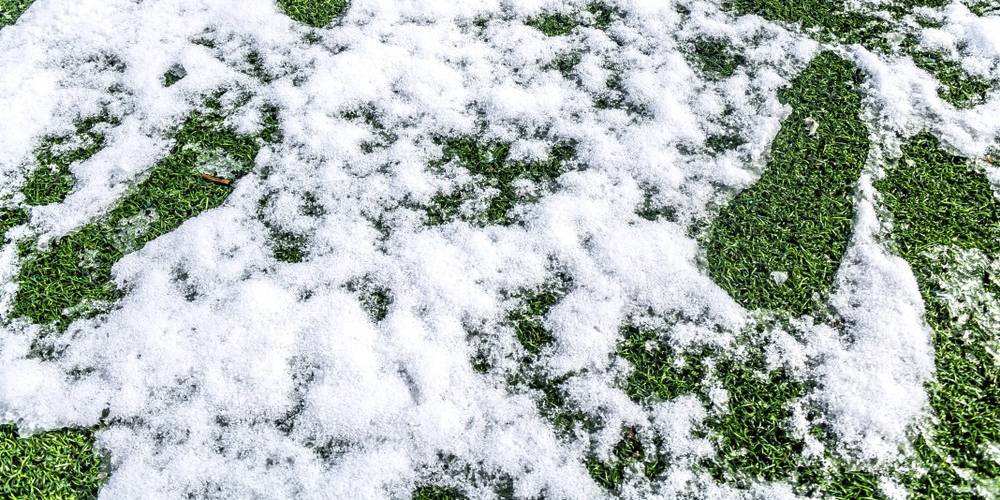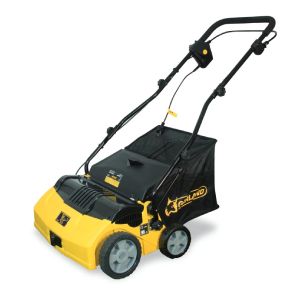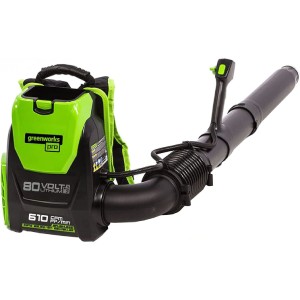- Duralawn
- Artificial Grass Maintenance
- Artificial Grass Winter Care
Artificial Grass Winter Care
Artificial grass winter care is really simple and one of the many benefits of artificial grass. In Canada and the United States most high quality synthetic grasses are specifically engineered to withstand extreme hot and cold temperatures. This includes snow, frost and freezing weather conditions that are a constant for some areas during the winter months. This all leads ultra low maintenance and peace of mind when it comes to taking care of artificial grass in winter and the rest of the year in North America.

Artificial grass winter care is a common concern for first time owners and it really is nothing to worry about as long as your grass is high quality. The snow actually acts as an insulator against the elements so it's best to just leave the snow to accumulate and melt naturally. If you do have to remove the snow, use a plastic shovel, blower or broom. We've added a few questions we've received over the years and answers from our experts.
Artificial Grass Winter Care Guide
If your project was installed by a professional artificial grass installer you can take comfort knowing the drainage, infill and the grass itself is designed for your usage and specific climate. In Canada almost all grasses and putting greens are designed to withstand anything winter can throw at it, but be wary of cheap imitations that save money up front but end up only lasting a few years.
1. Remove Debris
Artificial grass winter care starts with making sure the grass is clean and in great shape heading into the winter months. As part of regular maintenance and making sure it looks good, a proper blooming with a power brush is recommended at least once a year. If the grass is matted from high traffic or you notice a lot of organic materials on the grass such as; dog stool, leaves or twigs you should brush the grass more often to prevent build up in the grass. The more often artificial grass stays clean and clear of debris, the better it will look, longer it will last and you'll help control weeds.
Keep artificial grass clear of debris as often as possible in warmer months. This can be done by simply using a blower to remove leaves or making sure that pet stool is removed as quickly as possible.
Power Broom for Artificial GrassIf you click on this link and make a purchase, we may earn a commission. |
2. Enzyme Cleaner
In addition to making sure the grass is clear of visible debris, it's a good idea to give it a good clean to make sure that invisible bacteria aren't growing before snow arrives. We recommend using an artificial grass cleaner with active bacteria fighting enzymes especially if you own dogs that use the grass area as a bathroom. This step likely isn't necessary for ornamental lawns or any area that doesn't receive human or pet traffic.
3. Winter Maintenance
Artificial grass winter care involves very little maintenance, if any if the grass is cleaned in the fall months. As snow falls and accumulates and melts in a never ending cycle you really don't need to do anything. If snow and ice sits on the grass it won't damage the grass itself, and as the snow melts it will drain through the under-layer as the ground thaws. Its one of those instances where the less you do, the better and we recommend just letting the snow melt naturally as the weather warms up.
If you do want to clear snow off the grass for pets or to create a walking path, use a plastic shovel that doesn't have any sharp edges that may snag the grass. An even better option is a push broom or a backpack blower if the snow is light enough to be moved by forced air. The main thing to think about is not harming the grass blades that are likely frozen, and not displacing the infill material that lays in the thatch layer of most artificial grasses.
GreenWorks Cordless Backpack BlowerIf you click on this link and make a purchase, we may earn a commission. |
4. Cover
An optional step when considering artificial grass winter care is to cover the area with a tarp or something similar. This option is useful for areas that aren't used during the winter months like putting greens and ornamental lawns. If you are unsure of the quality of your artificial grass, this might be a good idea to ensure it lasts for many years and withstands numerous winters with freezing temperatures. Putting green winter care is a great way to protect your investment and ensure the putting surface stays pristine year after year.
5. Spring Cleaning
In the springtime or when all the snow has melted away it's a great opportunity to give the grass a good clean. It's common to find a pile of pebbles, dirt and other debris along the front edge of lawns or anywhere snow is piled up along roadsides. If this debris is left unchecked you may notice that weeds start to grow in the infill that has been overtaken by organics. Give the grass a once over with an artificial grass rake, push broom or power brush and pay attention to areas where snow was piled next to roadways.

Artificial Grass Winter Care FAQs
If you are enjoying synthetic grass in your yard or business for the first time you likely have questions about artificial grass winter care. While artificial grass maintenance is remarkably easier than natural grass, there are some things to keep in mind including keeping the grass clean. As with most things, a bit of prevention will lead to a lot less headaches down the road and artificial grass is the same. There are a few things you can do to keep your grass healthy, looking great and lasting many years even in climates that receive a lot of snow and adverse weather.
Should I use salt to melt ice and snow on my artificial grass?
Should I use salt to melt ice and snow on my artificial grass?
We don't recommend using salt or an ice melter on your artificial grass. The salt and chemicals can collect in the infill and cause clogging that will prevent proper drainage. This can cause problems over time including moss, mould or bacteria that can flourish in grass that doesn't drain properly. We recommend using a broom, blower or plastic shovel to carefully remove snow if it's necessary.
Can artificial grass be damaged in winter?
Can artificial grass be damaged in winter?
Yes it's possible to damage artificial grass in the winter and a lot more likely if the artificial grass is low quality. It can be damaged by metal snow shovels or excess traffic on grass that is compacted with ice and snow. We recommend using the most versatile synthetic grass maintenance equipment, the blower/vacuum/mulcher to remove snow if it's needed and limit traffic throughout the winter months. An option is to use a cover, tarp or something to protect the grass if you expect extremely high traffic in a certain area.
All grasses are not created equally and there is a wide range of products on the market today. These range from cheap products imported from around the world all the way to high quality products produced in the United States. It's a general rule but you really get what you pay for when it comes to artificial grass. Artificial grasses are designed to last anywhere from 5 to 25 years and it often comes down to how long you want the grass to last versus how much you want to pay.
Can you lay artificial grass in winter?
Can you lay artificial grass in winter?
The short answer is no you can't lay artificial grass in winter. There are a few reasons why you can't install artificial grass in freezing temperatures. If the ground is frozen you can't secure the grass properly and makes it near impossible to prepare the base to professional standards. The grass itself needs to flex in the summer heat before it's installed otherwise you will inevitably get wrinkles in the grass as temperatures warm up. It's best to install artificial grass when the weather is at least 15℃ or 60℉.
Disclaimer
Please use all appropriate and proper safety precautions when attempting projects on this website. All projects are attempted at the reader's own risk.
Duralawn® participates in the Amazon Services LLC Associates Program, as an Amazon Associate we may earn a commission from qualifying purchases.
Duralawn® artificial grass installations, products and service in Kelowna, Vernon, Penticton, etc since 2018.


